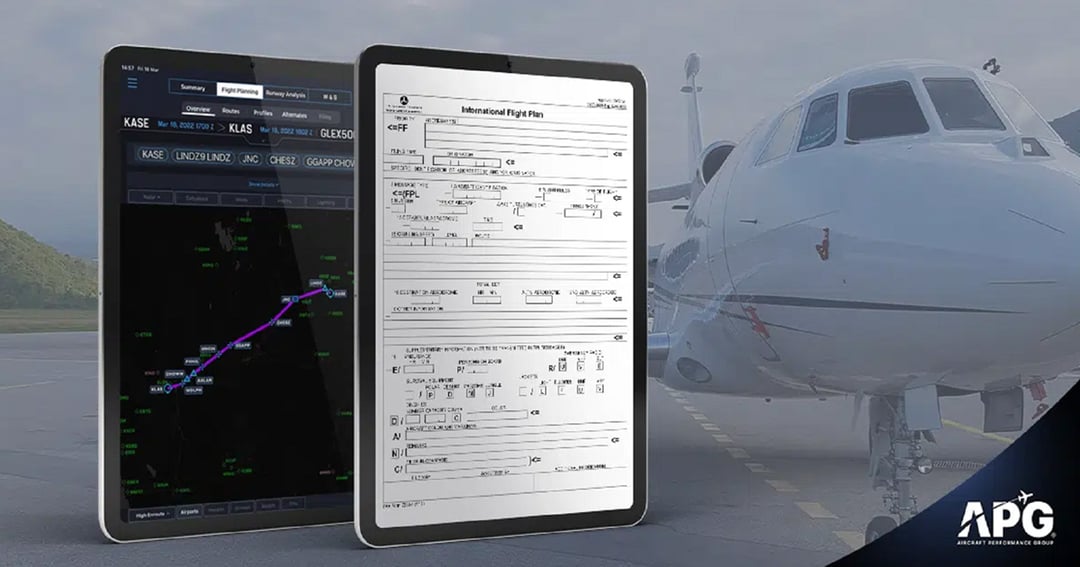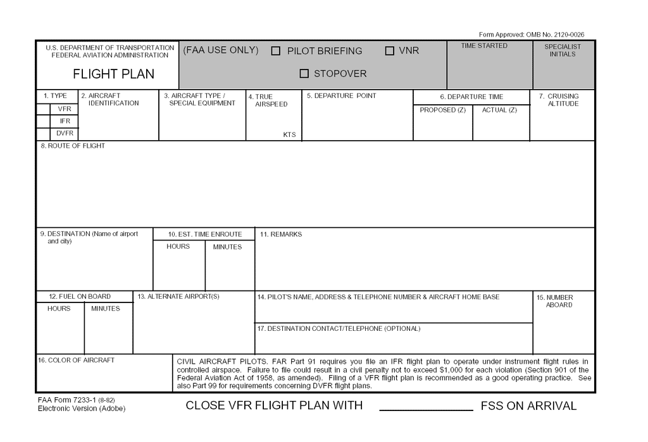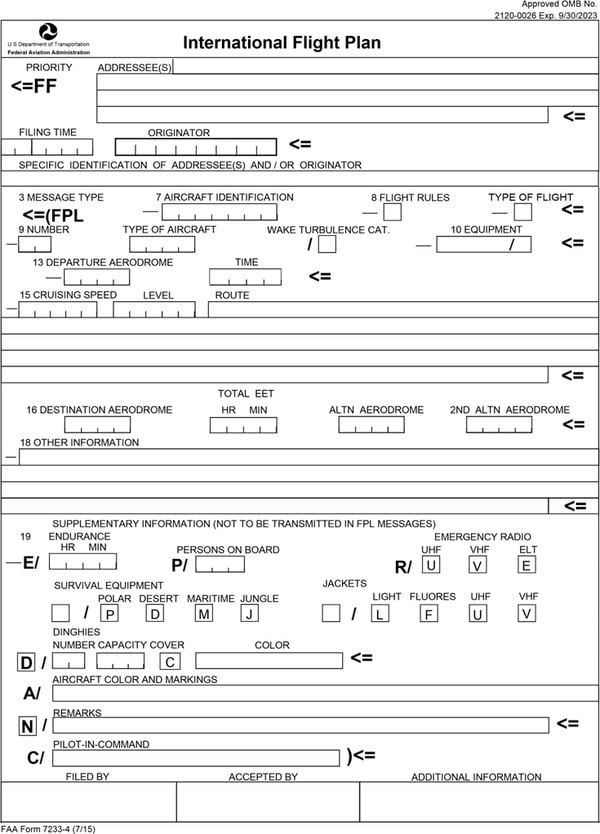
The purpose of flight planning is to ensure safe passage of an aircraft from one location to another. In the US there can be thousands of aircraft in the sky at any time and tens of thousands across the world. To avoid air traffic incidents, pilots use various “rules” based on their intended type of flying. Longer flights often use instrument flight rules (IFR) or international flight rules wherein pilots are required to file an FAA flight plan or ICAO flight plan. This ensures consistent communication and verification of flight data to keep our skies safe.
Types of Flight Planning Rules
- Visual Flight Rule (VFR) Flight Plans
- Instrument Flight Rule (IFR) Flight Plans
- Composite (VFR/IFR) Flight Plans
- International Flight Plans
- Defense Visual Flight Rules (DVFR) Flight Plans
VFR Flight Plans (Visual Flight Rules)
VFR flight plans are filed for flights that will be conducted under visual flight rules. This is a set of regulations under which a pilot operates an aircraft in weather conditions generally clear enough to allow visual contact with the ground and other aircraft during flight. VFR flight plans are typically filed for short distance flying in fair weather conditions.
VFR flights are a popular option for pilots who want to enjoy the freedom of flying without the requirements and restrictions of IFR flights. IFR flights require additional aircraft instrumentation in addition to the pilot having extra training and examinations. Because visual flight rules are “see and avoid” flying, VFR pilots are not required to have any communication or navigational equipment on board the aircraft. However, though the threshold is lower to get airborne with VFR it is important to be aware of the risks and only fly in conditions that are within the capabilities of the aircraft and pilot.
Requirements for VFR flights
(requirements can vary by jurisdiction so check local rules before getting airborne)
- Visibility: The pilot must be able to see at least 3 miles (5 km) ahead.
- Cloud Clearance: The pilot must be at least 500 feet (150 m) above any clouds, or 1,000 feet (300 m) below any clouds, or 2,000 feet (600 m) horizontally from any clouds.
- Daytime Only: VFR flights are only permitted during daylight hours.
Because pilots are flying by visual rules only, pilots are responsible for their own separation from other aircraft and obstacles. Pilots flying by Visual Flight Rules are not assigned specific routes or altitudes by air traffic control (ATC). VFR flight plans can be filed up to 24 hours before the estimated time of departure. If the flight is domestic (US) the VFR flight plan can be filed with the FAA. Though pilots are not required to file a VFR flight plan with the FAA, it is still recommended for tracking purposes in the event of an emergency.
Things to keep in mind when flying under VFR:
- Situational awareness: Always be aware of your position relative to other aircraft and obstacles. The skies can be busy and visual flight rules require a pilot to have situational awareness at all times.
- Visual references: Use visual references to help you stay oriented and avoid obstacles. References like roads, mountains, and large buildings can be used to recognize your location within space.
- Avoid flying in IMC: Do not fly in instrument meteorological conditions (IMC) unless you are instrument rated, have the proper equipment, and are confident enough in your abilities. This requires a special set of skills to navigate safely. One of the most common challenges is spatial disorientation, which can occur when the pilot loses their sense of orientation in space. This can be the case when flying at night with no visual reference to the ground as with VFR flying.
- File a flight plan: Even if you are not required to do so it’s good practice to file a flight plan. This will help air traffic control (ATC) track your flight and assist in the event of an emergency. By filing a flight plan, search and rescue (SAR) teams can be dispatched to the last known location based on your departure and arrivals times and follow your files flight path.
- Prepare for the unexpected: Changes in weather or mechanical problems can quickly force you to deviate from your initial plan or make navigating by VFR difficult. Have a backup plan or alternate airport considered in the event you need to alter your flight.
IFR Flight Plans (Instrument Flight Rules)
Instrument flight rules (IFR) are a set of regulations wherein a pilot operating an aircraft cannot see the ground or other aircraft at all times during the flight. It depends upon flying by reference to instruments in the flight deck instead of visual references like VFR. Navigation is accomplished by electronic signals from an in-panel system in the aircraft that tell the pilot information about heading, air traffic, obstacles, waypoints, etc… These are used for longer, cross country flight plans where instrument meteorological conditions (IMC) are expected.
Flying under Instrument Flight Rules requires pilots to have a thorough understanding of the aircraft’s instruments and equipment, as well as the ability to fly the aircraft accurately by reference to those instruments. Because IFR flights are more complex and require advanced skills, filing a flight plan is required by the Federal Aviation Administration (FAA) prior to departure. IFR flight plans must be filed at least 30 minutes before the estimated time of departure.
IFR flights require:
(flights under IFR may also have jurisdictional restrictions so please check local requirements before getting airborne)
- Instrument Rating: A pilot must have an instrument rating to fly under IFR. This rating is obtained by completing a training course and passing a written and practical examination. The pilot will be knowledgeable in how to use in-flight instruments including the airspeed indicator, attitude indicator, altimeter, turn coordinator, heading indicator, and vertical speed indicator.
- Current Training: A pilot must be current to fly under IFR. This means that the pilot must have flown six instrument approaches within the preceding six months to satisfy the instrument rating threshold.
- Equipment: An aircraft must be equipped with certain instruments and equipment to fly under IFR. This equipment can include a navigation system, a communication system, and an autopilot.
Advantages of flying under IFR:
- The ability to fly in any weather conditions: IFR flight allows pilots to fly in any weather conditions, regardless of whether they can see the ground or other aircraft.
- The ability to fly longer distances: IFR flight allows pilots to fly longer distances, as they are not limited by the need to stay in visual contact with the ground.
- The ability to fly at higher altitudes: IFR flight allows pilots to fly at higher altitudes, where the weather is often better.
Disadvantages of flying under IFR:
- Specialized training and equipment: IFR flight requires specialized training and equipment, which can be expensive.
- Increased complexity: IFR flight is more complex than VFR flight and requires pilots to have a thorough understanding of the aircraft’s instruments and equipment.
- Potential for spatial disorientation: Spatial disorientation is a condition in which the pilot loses their sense of orientation in space. This can be a serious hazard during IFR flights and can lead to accidents.
Overall, IFR flight is a safe and efficient way to fly in any weather conditions. However, it is important to be aware of the risks and challenges associated with IFR flight, and to only fly under IFR if you are properly trained and equipped.
Composite Flight Plans (VFR/IFR)
Composite flight rules (also known as IFR/VFR flight rules or IFR-VFR transition flights) are a type of flight plan that allows pilots to fly under both visual flight rules (VFR) and instrument flight rules (IFR) during the same flight. Typically, IFR/VFR flight plans begin and end in VFR conditions but will have a portion of the flight conducted under IFR conditions. For example, a pilot might file a composite flight plan for a flight from a small airport with no instrument approaches to a larger airport with several instrument approaches. Composite flight plans are also a useful way to fly in areas where the weather conditions may change during the course of the flight and offer the ability to fly longer routes than VFR alone. Because of the transition that composite flight planning requires, it is necessary to carefully plan the anticipated flight path as rules and conditions change mid-flight.
Filing a Composite Flight Plan
To file a composite or mixed flight plan, the pilot must be qualified to fly under both VFR and IFR conditions. They must specify the point(s) at which the change of flight rules is expected to occur and file two separate flight plans for each leg of the flight.
For example, if the pilot is flying under IFR from point A to point B, they must file an IFR flight plan and have clearance to fly from the departure point. If a pilot will depart under a VFR plan that has been filed, it must be filed, activated, and closed prior to the start of the Instrument Flight Rules segment. The pilot can signify with an intent to terminate the VFR at an airborne point (or fix) before beginning the IFR segment. Likewise, if the pilot chooses to terminate the VFR segment of the flight, they must contact the FSS (Flight Service Station) to activate the VFR portion of the flight.
Before beginning an IFR segment, pilots are required to get clearance from the appropriate ATC. As with filing a flight plan for VFR and IFR through traditional methods, pilots may also choose to file through a flight planning app.
International Flight Plans (ICAO Flight Plans)
International flight plans are filed for flights that will be conducted outside of the United States. They are filed with the International Civil Aviation Organization (ICAO) and the air traffic control authority in the countries where the flight will begin and end. In the United States, international flight plans are filed with the FAA’s International Flight Plan Office.
The information required for an international flight plan varies depending on the specific countries involved, but typically includes:
- Name and location of the airport where the flight will depart
- Name and location of the airport where the flight is expected to arrive
- Registration number (or tail number) of the aircraft
- Type of aircraft that is flying
- Name and contact information of the pilot in command and co-pilot
- Names and contact information of all other crew members
- Number of passengers on board
- Estimated time of departure from the departure airport.
- Estimated time of arrival at the expected arrival airport.
- Planned route of flight, including all waypoints and altitudes.
- Alternate airports that will be used in case of bad weather or other problems.
- The amount of fuel on board the aircraft.
- Type of communication equipment on board the aircraft.
- Any special equipment on board the aircraft, such as life rafts or survival gear.
International flight plans require more information than domestic flight plans because ATC in different countries require different information to safely manage the flight based on their regulations. The filing requirements for international flight plans can greatly vary depending on the specific countries involved. In some cases, international flight plans must be filed days in advance, while in other cases they can be filed 24 hours before departure.

DVFR Flight Plans (Defense Visual Flight Rules)
DVFR flight plans are filed for flights that will be conducted under visual flight rules (VFR) within a designated defense area. These types of flight plans are typically filed by military aircraft to ensure they are properly identified and tracked by ATC to prevent national security incidents from unauthorized aircraft entering US airspace. Any aircraft that plans to cross the boundary of the US from an airborne point must be identified under DVFR prior to entering US airspace. The ADIZ or Air Defense Identification Zones in the US, is an area over land or water intended to control civil aircraft through location and identification prior to entering the country. Before an aircraft can cross the AZID, a Defense Visual Flight Rules flight plan must be filed, activated, and closed so that NORAD is able to track the aircraft.

DVFR flight plans require:
- Filing with the appropriate air traffic control (ATC) facility. The flight plan is then forwarded to NORAD.
- Receiving and transmitting by discrete transponder code prior to entering the defense area.
- Maintaining two-way radio communication with ATC while within the defense area.
- Notifying ATC prior to departing the defense area.
It is important to be aware of the differences between the types of flight plans and their requirements before taking to the skies. By filing the correct type of flight plan and providing all of the required information, you can help to ensure a safe and efficient flight.


